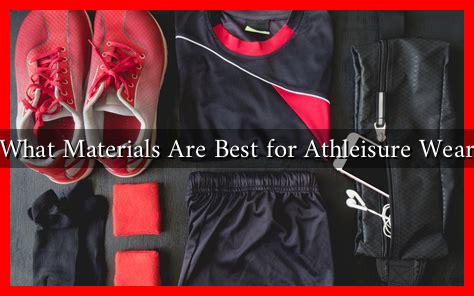-
Table of Contents
What Materials Are Best for Athleisure Wear
Athleisure wear has become a staple in modern wardrobes, blending comfort, style, and functionality. As the demand for versatile clothing that can transition from the gym to casual outings grows, understanding the materials that make up athleisure wear is crucial. This article explores the best materials for athleisure, their benefits, and how they contribute to performance and style.
The Rise of Athleisure
The athleisure trend has surged in popularity over the past decade, with the global athleisure market projected to reach $257.1 billion by 2024, according to a report by Grand View Research. This growth is driven by a shift in consumer preferences towards comfortable yet stylish clothing that can be worn in various settings. As a result, brands are increasingly focusing on the materials used in their athleisure collections.
Key Materials for Athleisure Wear
When it comes to athleisure wear, the choice of material can significantly impact comfort, durability, and performance. Here are some of the best materials commonly used in athleisure clothing:
- Polyester: Known for its durability and moisture-wicking properties, polyester is a popular choice for activewear. It dries quickly and retains its shape, making it ideal for high-intensity workouts.
- Nylon: This lightweight and stretchy fabric is often blended with other materials to enhance flexibility. Nylon is resistant to abrasion and provides excellent breathability, making it suitable for both workouts and casual wear.
- Spandex (Lycra): Spandex is renowned for its exceptional elasticity. It allows for a full range of motion, making it a common addition to leggings and fitted tops. The inclusion of spandex in fabrics ensures that athleisure wear maintains its shape even after multiple washes.
- Merino Wool: For cooler climates, merino wool offers natural temperature regulation and moisture-wicking properties. It is soft against the skin and odor-resistant, making it a great option for layering.
- Bamboo Fabric: An eco-friendly alternative, bamboo fabric is soft, breathable, and has natural antibacterial properties. It is becoming increasingly popular among sustainable fashion brands.
Performance Features of Athleisure Materials
Choosing the right material for athleisure wear goes beyond comfort and style; performance features are equally important. Here are some key performance attributes to consider:
- Moisture-Wicking: Fabrics that wick moisture away from the body help keep the wearer dry during workouts. Polyester and nylon are particularly effective in this regard.
- Breathability: Breathable materials allow air circulation, preventing overheating during physical activities. Look for fabrics with mesh panels or those specifically designed for breathability.
- Stretchability: Materials with spandex or elastane provide the necessary stretch for unrestricted movement, making them ideal for yoga, running, and other activities.
- Durability: High-quality materials resist wear and tear, ensuring that athleisure garments last longer, even with frequent use.
Case Studies: Brands Leading the Way
Several brands have successfully harnessed the power of innovative materials in their athleisure lines:
- Lululemon: Known for its high-performance fabrics, Lululemon uses proprietary materials like Luon and Nulu, which offer a blend of stretch, breathability, and moisture-wicking properties.
- Nike: Nike’s Dri-FIT technology is designed to keep athletes dry and comfortable by moving sweat away from the body. The brand frequently incorporates recycled polyester into its products, promoting sustainability.
- Outdoor Voices: This brand focuses on using sustainable materials, including recycled polyester and organic cotton, to create stylish and functional athleisure wear.
Conclusion
In conclusion, the materials used in athleisure wear play a pivotal role in determining the comfort, performance, and sustainability of the clothing. Polyester, nylon, spandex, merino wool, and bamboo fabric are among the best choices for creating versatile and functional athleisure pieces. As the market continues to evolve, consumers can expect to see more innovative materials that not only enhance performance but also align with sustainable practices. By understanding these materials, shoppers can make informed choices that suit their lifestyle and values.
For more insights on athleisure trends and materials, visit Grand View Research.

